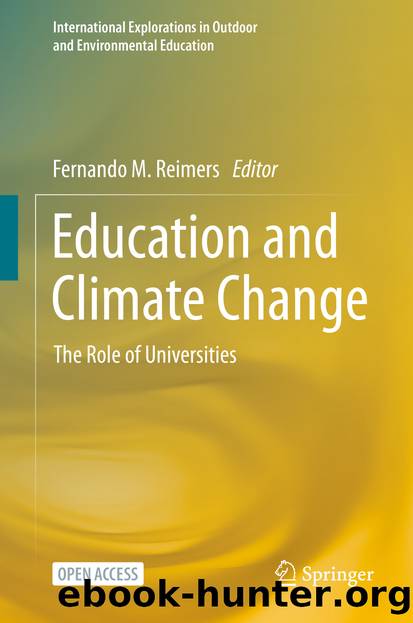Education and Climate Change by Unknown

Author:Unknown
Language: eng
Format: epub
ISBN: 9783030579272
Publisher: Springer International Publishing
3.8 Community Partnerships
Another aspect UNESCO identifies as crucial to the whole-school approach is the formation of partnerships between schools and community organizations. Through such partnerships, students are able to both learn about the climate and apply said learning outside of the classroom. These relevant, hands-on learning experiences can help students feel better connected to their communities and can create an experience that is a âmore effective and long-lasting form of learningâ (Beard and Wilson 2006, p. 1). Research indicates that as a result of these experiences, students may be more likely to take action towards solving real problems their communities are facing (Karpudewan and Khan 2017).
Community partnerships also present potential opportunities for professional development for teachers. For example, Marlow and McLain (2011) found that teachers reported a multitude of benefits when participating in experiential learning experiences within various community settings themselves. Experiential learning for educators can, much like for students, serve as âpotentially transformative experiences and provide numerous opportunities to touch teachers in unique and highly personal waysâ (Marlow and McLain 2011, p. 9). Such experiences for teachers also help to address any worries about implementing these methods in their classrooms (Girvan et al. 2016). In this case, experiential learning in conjunction with local organizations could potentially increase teacher comfort with incorporating climate-action objectives into their curriculum. As a result, schools observe increased implementation in classrooms (Girvan et al. 2016).
Upon review of whole-school approaches to sustainability worldwide, Henderson and Tilbury reported that âpartnerships are key components of program design and implementation and in many cases are seen as critical to the programâs successâ (2004, p. 19). These partnerships vary, in that some partnerships exist between a school and government authorities, while other schools may partner with civil sector organizations. Additionally, schoolsâ motivations for establishing partnerships may differ. Some partnerships may be intended to increase financial support, while other partnerships may serve as vehicles to serve the local community (Henderson and Tilbury 2004). New Zealandâs Enviroschools Program utilizes partnerships with a variety of stakeholders. Through their partnership with the Ministry of Education, for example, Enviroschools are able to âstrengthen the capacities of teachers and professionals to work effectively in [environmental education]â (Henderson and Tilbury 2004, p. 21). Partnerships create valuable opportunities for schools committed to mitigating climate change.
A partnership already exists between AMA and local organization, Amigos del Lago. The organization is a non profit association that works to âeducate, research and ensure [Lake Atitlánâs] conservationâ (Asociación Amigos del Lago de Atitlán 2018). Amigos del Lago has already helped to enhance environmental science lessons at the school through providing hands-on activities, and representatives from the organization have previously assisted with the school science fair as judges. We see that this partnership has the opportunity to expand, and is also an indication of the schoolâs willingness to partner with other organizations.
With this in mind, our guidebook recommends that schools should partner with various local organizations that share âa common visionâ with the school and that prioritize sustainable practices, (Blank et al. 2012).
Download
This site does not store any files on its server. We only index and link to content provided by other sites. Please contact the content providers to delete copyright contents if any and email us, we'll remove relevant links or contents immediately.
The Art of Coaching Workbook by Elena Aguilar(48033)
Trainspotting by Irvine Welsh(20043)
Twilight of the Idols With the Antichrist and Ecce Homo by Friedrich Nietzsche(17702)
Fangirl by Rainbow Rowell(7825)
Periodization Training for Sports by Tudor Bompa(7323)
Change Your Questions, Change Your Life by Marilee Adams(6636)
This Is How You Lose Her by Junot Diaz(5753)
Grit by Angela Duckworth(4728)
Red Sparrow by Jason Matthews(4654)
Asking the Right Questions: A Guide to Critical Thinking by M. Neil Browne & Stuart M. Keeley(4564)
Paper Towns by Green John(4163)
Room 212 by Kate Stewart(4099)
Ken Follett - World without end by Ken Follett(3968)
The Sports Rules Book by Human Kinetics(3581)
Housekeeping by Marilynne Robinson(3395)
The Motorcycle Diaries by Ernesto Che Guevara(3325)
Introduction to Kinesiology by Shirl J. Hoffman(3297)
Exercise Technique Manual for Resistance Training by National Strength & Conditioning Association(3285)
Double Down (Diary of a Wimpy Kid Book 11) by Jeff Kinney(3267)
